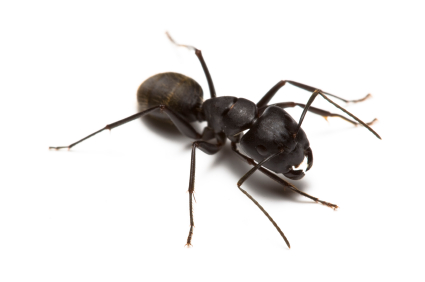Carpenter Ants

- Carpenter Ant Pictures and Info When on this PDF, if you can zoom in, you will see better detail of the damage done by Carpenter Ants and a good look at a nest we came upon within a Railroad Tie.
The Physical Characteristics of Carpenter Ants
Carpenter ants maybe black in color with reddish legs or a combination of red and black with black legs, depending on the species. They are polymorphic, varying in size. Minor workers can be as small as 1/4 inch, with Majors being up to 3/4 inch. The colony consists of Queens, Males and Workers.
Each ant hatches out their actual size, each size having their own specific job to do within the colony. The evenly convex thorax profile and the single petiole located between the thorax and the abdomen distinguishes the Carpenter Ant from the rest of the ant species. Their antenna is elbowed.
When the ant has been feeding you will notice that the abdomen extends, causing a striping effect. Carpenter Ants do not have the ability to sting, but they will pinch with their mandibles.
Carpenter Ants Habitat
Carpenter ants dwell in logs, stumps, in the ground or even under rocks. Their purpose in our environment is to break down wood, which is a very important element in the balance of our world. Carpenter Ants Do Not consume wood. They nest in logs, stumps and live trees by excavating the wood, turning it into frass (sawdust) and kicking it out of their way. Frass is the evidence that there is a carpenter ant infestation.
Bringing in landscape material such as bar, hog fuel or landscape timbers can enhance a Carpenter Ant environment. That is why Railroad ties are a bad idea in landscaping after all…they are logs cut into beams.
When your home becomes a satellite colony by ants trailing from their parent colony, you may hear a crackling sound within your wall voids similar to that of Rice Crispies in milk. It is not necessary, nor should you, open up a wall void for treatment. The nest does not have to be exposed to kill the colony and it is not necessary to remove the nest.
Biology of Carpenter Ants
Carpenter Ants typically go dormant during the cold winter months. In the Pacific Northwest, they will usually do their first swarming the first warm day in May. They will do a second swarming sometime around June or July.
The males are the first to take flight when the temperature is warm enough. When they don’t return to the nest the queens know it is time to take flight to swarm. It is during flight that the two will mate. After mating the queen will pull off her wings and seek out a nesting area. It takes 100% humidity for her to start her first brood.
The males will die after mating due to the fact that they can not take care of themselves. She will raise the first brood and after that, her sole purpose is the production of eggs. The new brood will then forage for food to feed the queen and the ever-growing nest.
Due to the fact that the queens need 100% humidity, she will not start her nest in your home, unless of course, you have a water problem providing that humidity. When a nest gets larger satellite colonies are developed.
Carpenter Ants in a satellite colony will traffic between their original parent colony and the satellite colony. The damage they will do is the same as what you see in logs. Ever notice the logging trucks carrying logs with hollowed out heartwood?
For further information, click on the link below.
Courtesy of Washington State University Extension
For treatment information, click on the link below.




 Follow
Follow

